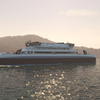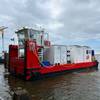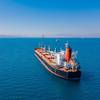With global steel demand running at an unprecedented level, rapidly rising prices have been a constant headache for ship repairers, as well as ship builders, in recent months. And despite sharply higher steel output, there is little sign of any softening as the New Year dawns.
According to the International Iron and Steel Institute (IISI), crude steel production for the 62 countries reporting their figures was 945m tonnes by the end of November, up 9% on the corresponding period one year earlier. Analysts were expecting total production to break through the billion tonne mark easily by the end of the year for the first time ever. IISI figures show that China accounted for the largest increase in output. To the end of November, Chinese steel mills had produced 245m tonnes, up a staggering 22% on the year before. The Chiense total was approximately twice the output of the whole of North America, an increase of just under 8% on one year before.
However, whilst higher production is going some way to meeting recent hikes in demand, there is still a net shortage of steel and prices have continued to firm as a result. According to MEPS International, a steel industry analyst based in Sheffield, UK, steel prices have risen by 150% in the last three years. “We are completing the most tumultuous year that the world’s steel markets have ever seen”, the analyst stated recently in one of its market reports. “Steel consumption is at record levels. It is scarely surprising that steel prices have been at historic highs”.
The analyst, which tracks steel prices across a range of production areas, reckons the average price for flat rolled products in December is US$724 per tonne compared with $449 a tonne twelve months ago and $373 in December 2002. “On an index basis, taking prices in January 1997 as being equal to 100, we find that the world average flat product price fell to a historic low point of 63.2 in January 2002. Since then, however, there has been an almost continuous climb, until the index for this month stands at 163.4, up 150% in three years”, MEPS declares.
Moreover, the declining dollar has made matters worse. The effect has been to inflate steel product values in countries such as those of the Eurozone and Asia although MEPS stresses that China is an exception because its currency is pegged to the dollar. Meanwhile flat steel prices are highest in Europe, with an average price of $794 coming in higher than North America’s $780, which itself has eased slightly over the last quarter from a high point of $860.
However, international steel prices are showing little sign of easing, according to a senior steel industry executive. Pascal Ponty, managing director of Arcelor’s Building and Construction Support division, told an industry meeting in Paris that economists at the world’s largest steel producer had been surprised by the continuing high price of steel. The surge in prices brought about by demand from China shows no sign of slowing down, he said, noting that the company’s economists had expected Chinese demand to tail off and prices to come down during the autumn.
Output has risen, Ponty said, but not fast enough to match demand. Moreover manufacturers are constrained by shortages of raw materials, particularly coke, and shipping capacity. This has resulted in waiting lists of up to 18 months for some types of steel, he said. And the shipbuilding boom in the Far East is itself increasing demand for steel still further.
Subscribe for
Maritime Reporter E-News
Maritime Reporter E-News is the maritime industry's largest circulation and most authoritative ENews Service, delivered to your Email five times per week










